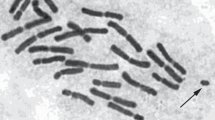Summary
A hyperdiploid aneuploid karyotype, consisting of 7 chromosomes, has been found in a tumorous suspension cell culture ofCrepis capillaris (2 n=6). Giemsa C-banding has revealed that these 7 chromosomes show consistent patterns of differential staining in all dividing cells. This stable karyotypic situation has persisted during 18 months of cytological monitoring of the culture. Comparison with the diploid C-banded complement of the root tip indicates that numerous structural rearrangements must have occurred during the formation of the aneuploid complement. A likely pathway for evolution of this karyotype involves initial tetraploidy followed by chromosome loss. Such a mechanism has previously been proposed for a plant tissue culture system (Bayliss andGould 1974) and commonly occurs in animal systems, particularly in animal tumours (Terzi andHawkins 1975). An alternative mechanism, which does not necessarily involve tetraploidy, is also proposed.
Similar content being viewed by others
References
Ashmore, S. E., Gould, A. R., 1979: Cell cycle analysis of tumour-derived cultures ofCrepis capillaris: A kinetic analogy with proliferation of animal tumour cells. Protoplasma101, 217–230.
Barlow, P., 1973: The influence of inactive chromosomes on human development. Anomalous sex chromosome complements and the phenotype. Humangenetik17, 105–136.
Bayliss, M. W., 1973: Origin of chromosome number variation in cultured plant cells. Nature246, 529–530.
- In press: Chromosomal variation in plant tissues in culture. Int. Rev. Cytol. Suppl.
—, 1974: Studies on the growth in culture of plant cells. XVIII Nuclear cytology ofAcer pseudoplatanus suspension cultures. J. exp. Bot.25, 772–783.
Brossard, D., 1978: Microspectrophotometric and ultrastructural analyses of a case of cell differentiation without endopolyploidisation: the pith ofCrepis capillaris (L.) Wallr. Protoplasma93, 369–380.
Dolfini, S. F.,Halfer, C., 1978: Spontaneous chromosomal change in established cell populations ofDrosophila melanogaster.In: Origin and Natural History of Cell Lines, Progress in Clinical and Biological Research (Barigozzi, C., ed.)26, 125–147.
Ford, C. E., 1964: Selection pressure in mammalian cell populations. In: Cytogenetics of Cells in Culture (Harris, R. J. C., ed.), pp. 27–45. New York: Academic Press.
Halfer, C., Privitera, E., Barogozzi, C., 1980: A study of spontaneous chromosome variations in seven cell lines derived fromDrosophila melanogaster stocks marked by translocations. Chromosoma76, 201–218.
Hashmi, S., Allardice, P. W., Klein, G., Miller, O. J., 1974: Chromosomal heterogeneity in the RAG and MSWBS mouse tumor cell lines. Cancer Res.34, 79–88.
Hsu, T. C., 1961: Chromosomal evolution in cell populations. Int. Rev. Cytol.12, 69–161.
John, B., Lewis, K. R., 1968: The chromosome complement. Protoplasmatologia VIA. Wien-New York: Springer.
King, M., 1980: C-banding studies on Australian hylid frogs: secondary constriction structure and the concept of euchromatin transformation. Chromosoma80, 191–217.
Krune, W., Wolf, U., 1977: Chromosome variation and gene action. Hereditas86, 31–36.
Levan, A., Biesele, J. J., 1958: Role of chromosomes in carcinogenesis as studied in serial tissue culture of mammalian cells. Ann. N. Y. Acad. Sci.71, 1022–1053.
Makino, S., 1957: The chromosome cytology of the ascites tumours of rats, with special reference to the concept of the stemline cell. Int. Rev. Cytol.6, 25–84.
Papes, D., Jelashka, S., Tomasco, M., Devide, Z., 1978: Triploidy in callus culture ofVicia faba L. investigated by the Giemsa C-banding technique. Experientia34, 1016–1017.
Sacristán, M. D., 1971: Karyotypic changes in callus cultures from haploid and diploid plants ofCrepis capillaris (L.) Wallr. Chromosoma33, 273–283.
—, 1975: Clonal development in tumorous cultures ofCrepis capillaris. Naturwissenschaften62, 139–140.
—, 1973: Tumorous cultures ofCrepis capillaris: chromosomes and growth. Chromosoma43, 279–288.
Schweizer, D., 1973: Differential staining of plant chromosomes with Giemsa. Chromosoma40, 307–320.
Sidorov, B. N., Sokolov, N. N., 1963: Chromosomal lysis in spindle blocking. (In Russian.) Dokl. Akad. Nauk. SSSR.150, 3, 653.
Singh, B. D., 1975: Evolution of dominant karyotypes inHaplopappus gracilis cells culturedin vitro. Caryologia28, 29–37.
Sokolov, N. N., Sidorov, B. N., Durimanova, S. A., 1974: Genetic control of DNA replication in chromosomes of eukaryotes. Theor. app. Genet.44, 232–240.
Sunderland, N., 1973: Nuclear cytology. In: Plant Tissue and Cell Culture (Street, H. E., ed.), pp. 161–190. Oxford: Blackwell.
Tanaka, R., Komatsu, H., 1977: C-banding patterns in somatic and meiotic chromosomes ofCrepis capillaris. Proc. Jap. Acad.53, Series B, 6–9.
Terzi, M., Hawkins, T. S. C., 1975: Chromosomal variation and the establishment of somatic cell linesin vitro. Nature253, 361–362.
Tiepolo, L., Zuffardi, O., 1973: Identification of normal and abnormal chromosomes in tumour cells. Cytogenet. Cell Genet.12, 8–16.
Author information
Authors and Affiliations
Rights and permissions
About this article
Cite this article
Ashmore, S.E., Gould, A.R. Karyotype evolution in a tumour derived plant tissue culture analysed by Giemsa C-banding. Protoplasma 106, 297–308 (1981). https://doi.org/10.1007/BF01275560
Received:
Accepted:
Issue Date:
DOI: https://doi.org/10.1007/BF01275560




